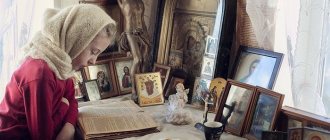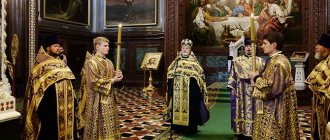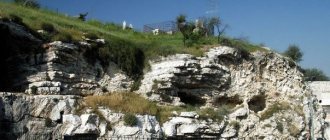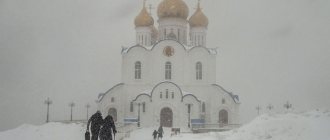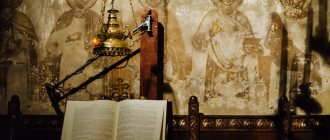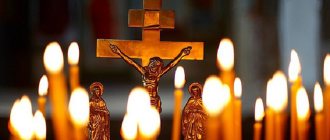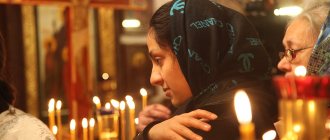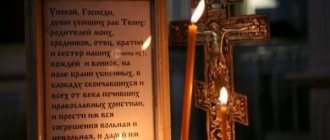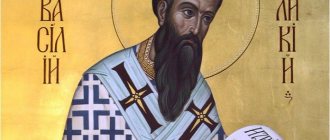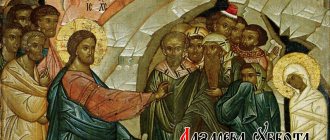Easter Matins
Easter Matins begins at 12 o'clock at night with a solemn religious procession around the temple. The clergy, dressed “in all the most luminous dignity,” with a cross, the Gospel, icons and banners, surrounded by worshipers with lighted candles, to the joyful ringing of bells, leaves the temple as if to meet the coming Savior, singing the stichera: “Thy Resurrection, O Christ the Savior, The angels sing in heaven: grant us on earth also with a pure heart to glorify You.” The angel's song is already sounding in the heavens, and people are still walking in the darkness of the night, but the heart is already trembling in anticipation of the all-illuminating joy of the Resurrection. Having walked around the temple, the procession stops in the vestibule in front of closed doors, as if at the entrance to the tomb
The Lord's. And then the joyful news is heard: “Christ is risen from the dead, trampling down death by death and giving life to those in the tombs.” The doors open - and the entire sacred host solemnly enters the temple shining with lights. The singing of the Easter canon begins. According to the interpretation of the synaxarion (summary - the result of the service - a short reading placed after the 6th song of the canon), the word "Easter" means "translation"; from non-existence to being, from hell - to heaven, from death and corruption - to immortality, which and is the original and natural state of man. The Easter canon begins with the chanting of Easter, as the “translation” of human life to its original sources - immortality, eternal life.
Easter Matins. Song 1. Irmos.
Resurrection day, let us enlighten ourselves people:
Easter, the Lord's Easter (that is, the transition to another existence) for from death to life and from earth to heaven, Christ God led us, singing the song of victory.
Chorus: Christ is risen from the dead.
Troparion: Let us purify our senses and see Christ, shining with the unapproachable light of the resurrection, and we will clearly hear “rejoice” from Him, singing the song of victory.
Together with the rejoicing earth, the heavens also rejoice, the whole world celebrates - visible and invisible - the angelic world, for Christ has risen - eternal joy.
Easter Matins. Song 4. Irmos.
On divine guard, may the God-speaking Habakkuk stand with us and show us a luminous Angel, clearly exclaiming: now is salvation for the world, for Christ has risen as omnipotent. (Opressed by the thought of the triumph of evil, the prophet Habakkuk tensely awaited news from God about the triumph of truth and the salvation of the world.)
Troparion: As a man, Christ appeared as a male being, the firstborn of His Virgin Mother and, as the true God, He is all-perfect, blameless, and not involved in the impurity of sin. Being the spotless Lamb, He became our Passover, our deliverance from corruption and death.
Easter Matins. Song 5. Irmos.
Let us rise early in the morning (“Let us morning deep”) and, instead of the precious world, let us offer our hymns as a gift to the Master and Christ. He is the Sun of Truth, giving life to everyone.
Troparion: Those who, after death, were in a state of immersion in spiritual darkness and torment and were “contained in the bonds of hell,” having seen the immeasurable mercy in the resurrection of Christ, rushed toward the light with joyful steps (cheerful feet).
There is life beyond the grave - this is the highest essence of the Easter celebration. Christ raised to life those who had died before His coming, but who were waiting for Him. He raised up those who died with faith in Him after His coming, just as He will also raise up those who are now dying and those who are about to die in this age. For all of them, for all of us, the posthumous expectation of His second glorious coming is only a three-day stay in the tomb, following the example and image of Christ Himself. On Easter days, believing people carry this joyful news to the graves of their departed.
Christ emerges from the tomb as the Bridegroom, let us approach Him with lamps in our hands and, together with the joyfully celebrating ranks of angels, we will celebrate God’s saving Easter.
Vigil for the Annunciation
Annunciation is one of the most revered holidays. On this day, “even birds don’t build nests,” this was the opinion of the old people. The whole world rejoices for the Most Pure Virgin Mary, who received the news of the gift of the Son of God to Her. She is the only one of all pious women honored by the Almighty to become the Mother of His Son.
In honor of this important news, a large church holiday was established. On the eve of it, a large All-Night Vigil service begins, which ends with the Liturgy of St. Chrysostom. In 2022, this celebration coincided with the fourth Week of the Veneration of the Cross. The Saturday evening service ends the Week of the Cross and begins the All-Night Vigil in honor of the Annunciation.
Because of this coincidence, the Liturgy of St. Chrysostom is shifted to the Friday evening service. Thus, she foreshadows the beginning of a new day and praises the Most Pure Virgin Mary. But in the evening service on the eve of the Annunciation, they will read the 5th chapter of St. Mark.
- The All-Night Vigil may follow the Vespers Service or Compline.
- If the evening service is served as coincidentally in 2022, then on the eve of the Annunciation on Saturday there will be Compline and then a Vigil.
Features of the All-Night Annunciation Vigil:
- If such a coincidence is not foreseen, then the evening service begins on the Saturday before the vigil. It is here that the Gifts of the Holy Spirit are consecrated.
- In cases where the celebration falls on a weekday from Tuesday to Friday, coinciding with the end of Pentecost, then the All-Night Vigil is preceded by Compline. And the evening service with liturgy always takes place a day earlier.
- If the celebration falls from Wednesday to Thursday during Holy Week, the All-Night Vigil begins with Compline. Vespers with liturgy take place a day earlier.
- If the celebration falls on Monday or Sunday, the All-Night Vigil begins with an evening service.
- If the celebration falls on Good Friday or Saturday, the vigil is canceled altogether. In this case, the service will be in the morning, which will be combined with the festive Annunciation service.
- If the celebration falls on Easter night, then the two services are combined together.
Easter Matins. Song 6th. Irmos.
Thou hast descended into the underworld of the earth and broken the eternal bonds that were bound, O Christ, and three days old, like Jonah from a whale, he rose from the grave.
Kontakion: “Even if you had descended into the grave, the Immortal One”... From the mystical heights of the thought of God, the kontakion again leads us to the historical event of the resurrection, and the ikos that follows tells us about the experiences of St. The Myrrh-Bearing Women, hastening to anoint the life-giving and buried body, the flesh of the One who raised Adam, but Himself lies in the tomb. Like the Magi, they rush to worship Christ, not in shrouds, but wrapped in a shroud. Their crying is replaced by a joyful vision of an Angel announcing their resurrection. This is followed by the singing of a Sunday song, which is repeated at every Sunday matins: “Having seen the Resurrection of Christ, let us adore the Holy Lord Jesus, the only sinless one, we worship Thy Cross, O Christ, and we sing and glorify Thy holy resurrection: for Thou art our God, is Thou no other We don’t know, we call Your name. Come, all you faithful, let us worship the holy resurrection of Christ: behold, through the cross joy has come to the whole world. Always blessing the Lord, we sing of His resurrection: having endured the crucifixion, destroy death by death.
All-night service Holy Saturday video
Conclusion:
The largest and most significant are the All-night services at Christmas, Annunciation, and Easter . The Easter service is considered special; it never has one date, but always begins to be celebrated on the evening of Holy Saturday. Then it smoothly transitions into the All-Night Vigil, then into the early morning service. Holy bread is consecrated there, believers confess and take communion.
All-night vigil is always a special time. The all-night Easter service is perfection itself, when the world rises from its knees to its feet from complete fall. He receives the forgiveness of the Almighty for the atoning sacrifice that the Savior made for us sinners. The ringing of bells plays the role of an evangelist; it announces to the world the resurrection of Christ. Believers in churches and the whole world are blessed by the ringing.
Easter Matins. Canto 8th.
The eighth canto reminds us that the joy of Easter is the joy of the Eucharist given by Christ to the whole world.
Tropari:
On this designated and holy day, “the feast of feasts and the solemnity of solemnities,” the faithful are invited to come and share in this joy.
Come, let us partake of the new fruit of the vine, divine joy, and the Kingdom of Christ.
Lift up your eyes around Zion (appeal to the New Testament Church, the Upper Room of Zion, where the Last Supper was celebrated) and see: behold, your children have flocked to you like God-bright lights from the west, north and sea and east, blessing Christ in you forever.
Canto 8 ends with the glorification of the Holy Trinity.
After the 8th song at the usual Matins there follows the song of the Theotokos “My soul magnifies the Lord.” Here it is replaced by special Easter choruses, glorifying the Suffering, Buried and Risen Christ. The 3rd chorus expresses the meaning and content of the entire Easter celebration:
Christ is the New Passover, Living Sacrifice, Lamb of God, take away the sins of the world.”
Christ is that “new” Easter, the fulfillment of which He spoke to His disciples at the Last Supper (Luke 22:15, 16). He is the living Sacrifice who was to stop all Old Testament sacrifices, the Lamb about whom the prophets prophesied (Isa. 53:7).
In the New Testament, St. Paul already definitely refers to Christ as “our” Passover, saying: “Our Passover is Christ” (1 Cor 5:7).
Thus the aspirations were fulfilled, the prophecies were fulfilled, and the secret Easter, the mysterious Easter, was openly revealed to people.
The 4th chorus is the Archangel greeting to the Mother of God:
“The angel cried out with the Most Grace: Pure Virgin, rejoice. And again the river: rejoice. Your Son is risen three days from the grave, and raised up the dead: people, rejoice.”
Easter Matins. Song 9. Irmos.
The Mother of God is the new Jerusalem, the New Testament Zion, the glory of the Church and the irmos of the 9th ode unites Her image with the image of the glorified Church of Christ: Shine, shine, new Jerusalem, for the glory of the Lord has risen upon you: rejoice now and be glad, Zion: You Rejoice, pure one, O Mother of God, about the rising of Thy Nativity.
In the troparia of the 9th canto, Paschal rejoicing reaches its highest tension. The soul is filled to the brim like a full cup and can no longer find words to express its bliss.
Tropari:
Oh, how divine, oh, how kind, oh, how sweet is Your voice, O Christ...
O great and most sacred Easter, Christ, Wisdom, Word of God and Power, deign us to commune more perfectly with You on the unevening day of Your Kingdom.
The next hymn, in clear and powerful words, again tells us about the unity of Easter of the Cross and Easter of the Resurrection.
The path to resurrection lies through death and the image of this path was given to us by Christ.
“Having fallen asleep in the flesh as if dead, Thou art the King and Lord, who rose for three days, raised Adam from aphids and abolished death: Easter is incorruptible, the salvation of the world.”
At the end of Matins, the solemn Easter stichera are sung.
1.Easter fast
The celebration of Easter (in a broad sense - as a remembrance of both the Crucifixion and the Resurrection of the Lord Jesus Christ) has been mentioned in church literature since the 2nd century, but it was celebrated by Christians, undoubtedly from the very birth of the Church. However, the date of the celebration of Easter before the First Ecumenical Council was determined differently in different localities and was not always strictly confined to a specific day of the week. The most important difference between Easter and other days of the church year, apparently, was fasting (in the sense of complete abstinence from food), lasting several hours or even up to two days and ending at dawn, when the Eucharist was celebrated, which served as a sign of joy about the Resurrection of Christ.
After the First Ecumenical Council, when the Roman practice of celebrating Easter without fail on Sunday spread everywhere, the celebration of Great Saturday as the day of pre-Easter fasting also became a widespread establishment; Thus, according to the 64th Apostolic Canon (later confirmed by the 55th Canon of the Trullo Council) and the “Apostolic Constitutions” compiled around 380 (VII. 23), Holy Saturday is the only fast Saturday of the year.
One of the subjects of disagreement already in the 3rd century was the question of the time of the end of the Easter fast. In the 1st canonical message sschmch. Dionysius of Alexandria (mid-3rd century) Bishop Basilides provides several points of view on this problem: according to Roman Christians, fasting should be allowed at the “loop announcement”, that is, at dawn (the same practice is recorded in the “Didascalia of the Apostles”, a monument to the 1st half of the 3rd century, and in the “Apostolic Constitutions” dependent on it); according to Christians in North Africa - as early as Saturday evening; sschmch himself. Dionysius proposes a compromise solution - to stop fasting between midnight and the 4th "watch", that is, until dawn. St. held the same opinion. Epiphanius of Cyprus1. According to a 5th-century Syrian monument entitled "The Testament of Our Lord Jesus Christ", the fast breaks at midnight; this same practice has become the norm in the Orthodox Church2.
Most importantly, the Easter fast was accompanied by an Easter vigil (an early description of its composition is contained in the Didascalia of the Apostles, which states that the vigil included prayers, reading the Old Testament, the Gospel and psalms); the Easter Eucharist served as its conclusion.
2.Easter and the sacrament of Baptism
Another important, although not universal (in any case, in the 3rd century it was recorded only as a local tradition of Rome and North Africa3), custom associated with Holy Saturday and Easter, was the custom of performing the sacrament of Baptism of converts immediately before the Easter Eucharist.
The connection between Christ's death on the Cross and the sacrament of Baptism, as a symbolic burial with Him in order to be resurrected with Him, is reflected in the Epistles of St. Paul (see Rom 6.4; Col. 2.12). The descent of Christ into hell is confessed as a separate dogma in the so-called Apostolic Creed, which is based on the baptismal symbol of the Roman Church. Thus, the main themes of the Easter holiday are closely linked with the theology and rites of the sacrament of Baptism.
By the middle of the 4th century, Baptism during Easter night became a widespread custom. Thus, according to the “Apostolic Constitutions,” reflecting the practice of the Antiochian Church, the fast of Holy Saturday continues “until rooster crowing” on Sunday; a vigil is held throughout the night, ending with the reading of the Holy Scriptures of the Old and New Testaments, the Baptism of the catechumens and the Eucharist (V. 19).
3.Ancient Easter Vigil and modern Vespers and the Liturgy of Holy Saturday
A ritual service consisting of evening prayers, lengthy reading of the Holy Scriptures (as well as the singing of some poetic biblical passages - first of all, songs from the book of Exodus Let us sing to the Lord and the song of the three youths), the sacrament of Baptism and, finally, the Eucharist, performed late in the evening on Holy Saturday , and is nothing other than the ancient Easter vigil. In modern liturgical practice of the Orthodox Church, this service, dating back to early Christian times, is well known under the name of Vespers and the liturgy of Holy Saturday. It has only two fundamental differences from the ancient Easter vigil - in practice, it does not take place on the night before Easter, but the morning before, and the sacrament of Baptism is not performed after it. Both of these differences will be commented on in more detail below.
3a. Vespers and liturgy of Holy Saturday in the cathedral worship of Constantinople in the 9th-11th centuries
The order of Vespers and the liturgy of Holy Saturday, which has been accepted in the Orthodox Church for about a millennium, goes back to the tradition of cathedral worship in Constantinople. The oldest known detailed description of the Holy Saturday service in the Church of Hagia Sophia in Constantinople is contained in the Typicon of the Great Church (its various lists reflect the practice of the 9th-11th centuries), the description of which can be supplemented using other Constantinople sources of the same time4.
According to these sources, Vespers on the evening of Holy Saturday had an unusually large number of paremias - 15 - during which the Patriarch of Constantinople baptized the catechumens and after which the Divine Liturgy was celebrated. The series of proverbs, which began after the usual vespers chants, opened with the prokeme from Psalm 65. During the second of the proverbs, the Patriarch, leaving the Gospel in his place on a high place, left the temple and went to the large baptistery located next to it, and the reading of the proverbs continued. In the baptistery, the Patriarch dressed himself in a white surplice and white shoes; the sacrament of Baptism began immediately with the incense of the fonts (there were two fonts - one for men and one for women) and the consecration of water, since all the preparatory rites were completed in advance, during Lent and Holy Week. After the consecration of water and oil, the water and those being baptized were anointed with the “oil of gladness” (in this case, the oil was poured by the Patriarch only on the heads of those being baptized, and then rubbed over the entire body of those being baptized by deacons and deaconesses [the first served at the Baptism of men, the second - women]) and the Baptism itself - immersion in the water of the font. No further ceremonies took place in the baptistery; Confirmation took place in the church.
According to the Typicon of the Great Church, during Vespers of Holy Saturday only the first seven proverbs were required to be read (Gen. 1. 1-5; Isa. 60. 1-16; Ex. 12. 1-11; Jonah 1. 1 - 4. 11; Josh 5 10-15; Exodus 13.20 - 15.19; Zeph 3.8-15; the reading of the proverbs was interspersed with singing - after the 3rd proverb the prokeimenon from the 26th psalm was sung, and the 6th proverb itself ended with a song , to which the chorus of Exodus 15.1b was added and a doxology was added at the end). But if the Patriarch and the newly baptized delayed in the baptistery, seven more could be added to the first seven (i.e., proverbs from 8 to 14: 1 Kings 17. 8-24; Isa 61. 10 - 62. 5; Gen. 22 1-18; Isa 61. 1-10; 2 Kings 4. 8-37; Isa 63. 11 - 64. 4; Jer 31. 31-34; this series of additional proverbs was also interspersed with singing - after the first three [i.e. that is, after the 10th overall proverb] the prokeimenon from the 92nd psalm was sung). If the Patriarch, together with the newly baptized, managed to return to the temple by the end of the 7th proverb, these additional proverbs were cancelled.
The last, 15th, proverb (Dan 3. 1-88 [according to the text of LXX]), on the contrary, was never canceled, since it had a special function: the song of the Babylonian youths that closed this proverb was sung (with the refrain Dan 3. 57b) and served as a greeting for the newly baptized who arrived at the temple and as a sign for the clergy to dress in white vestments. At the end of the song of the youths, when the Patriarch and the newly baptized were already standing in the right place at the entrance to the temple, the singers began to sing Elitsy in Christ, and at this time the Patriarch performed Confirmation (in the ancient tradition of Constantinople, the Seal of the gift of the Holy Spirit - anointing with holy chrism - was placed only on the forehead of those being baptized). Then the Patriarch and the newly baptized entered the temple, while Psalm 31 was sung (Blessed are they who remain). The Patriarch and concelebrants entered the altar, and the Divine Liturgy began - immediately with the Elitsa in Christ instead of the usual Trisagion. At the liturgy, neither the prokeimenon nor the alleluary were sung - the Apostle (Rom 6.3-11) was read immediately, and the alleluary was replaced by the 81st psalm. The Apostle of Great Saturday is the same as in the rite of the sacrament of Baptism (Brethren, as we were baptized into Christ Jesus), and the Gospel (Matthew 28.1-20) includes not only the usual baptismal reading, but also the full story of the Evangelist Matthew about the Resurrection Christ, sounding in the temple the only time a year - on this day. The usual cherubic song was sung5, involved - Ps 77.65.
3b. The further fate of the Constantinople rite of vespers and the liturgy of Holy Saturday: the statutes of the studite tradition and the Jerusalem statute
The Constantinople cathedral rite of Vespers and the liturgy of Great Saturday, with all its readings - paremias, the Apostle, the Gospel, etc. - passed into the Byzantine monastic regulations of the post-iconoclast era. These charters and their various editions (including the edition of the Jerusalem Charter, which is now accepted in the Russian Orthodox Church) are closely related to each other and, in general, represent different versions of one common tradition.
In the monastic regulations, the first important change occurs in the rite of Vespers and Matins on Great Saturday: since they were intended for use in monasteries, and the sacrament of Baptism in monasteries, as a rule, was not performed, the paremias of Vespers lost their liturgical (but not content! The content of the paremias of Great Saturday indicates how on Easter and on Epiphany) connection with the baptismal rite. In addition, the elements of vespers at the beginning of the rite, which in the Typikon of the Great Church corresponded to the “song sequence,” were replaced by the usual for monastic vespers Ps 103, the Lord called with stichera and the Quiet Light. A less significant change occurred with the rite of vespers of Great Saturday in the statutes of the studio tradition and then the Jerusalem Charter - the omission of the prokeimones after the 3rd and 10th paroemias and the movement of the prokeimne before the 1st paroemia to the Apostle (which, therefore, began to be preceded by the prokeimenon, while the paremias, on the contrary, lost the introductory prokeimenon).
Despite the exclusion of Baptism from the rite of Vespers and the liturgy of Holy Saturday, the baptismal hymn of Elitsa in Christ, the apostolic reading of the rite of Baptism, and, finally, the custom of dressing in white robes, indicating the shining robes of the newly baptized (and symbolically, the angels who preached the gospel of the Resurrection of Christ). Some monuments (for example, the Typikon of St. Gregory Mtatsmindeli and others) even talk about the tradition of two entrances at Vespers on Great Saturday: the first entrance, at ordinary times (before the Quiet Light), occurs with a censer and is performed by one priest; the second, after the proverbs, happens with the Gospel and is performed by all the clergy of the monastery; During this second entrance, the baptismal Psalm 31 is sung. This tradition was not transferred to the Jerusalem Rule.
The Jerusalem Rule further emphasized the connection between the Holy Saturday service and the usual Sunday service by comparing the first, that is, the Easter vigil, with the second, that is, the usual Sunday vigil. The main signs of such a comparison were: 1) the addition to the end of the liturgy of Holy Saturday of the prayer of blessing bread and wine, as at a regular vigil (but without wheat and oil - for the sake of fasting6), as well as the “great reading” - a long reading, during which the blessed bread and wine, in fact, should be partaken (on Holy Saturday such reading is the Acts of the Holy Apostles; readings of other Sundays of the year and vigil feasts have long gone out of actual practice), and 2) the addition of Vespers of Great Saturday with “quasi”-matins - the so-called Easter midnight office.
The Easter “midnight office” (the correct name for this service is pannikhis) contains the usual beginning (with the Trisagion), the 50th psalm, the canon of Great Saturday, the Trisagion, the Sunday troparion of the 2nd tone, the litany and dismissal. At the same time, the canon, according to the rules, must be performed, in fact, according to the rules of the canon of Matins (but not Compline, prayer or anything else): with katavasiya, on 14 and even with biblical songs (cf. the Typikon’s instruction: with verses song); on the canon the word St. should be read. Epiphany of Cyprus, amazing in its beauty.
The liturgical charter of the Russian Church prescribes that Vespers and the liturgy of Holy Saturday begin “at the tenth hour,” that is, around 17.00-18.00. Thus, the liturgy of Great Saturday is, according to the charter, the latest liturgy of the year.7 This fact, as well as the general order of the service of Great Saturday: 1) vespers - 2) liturgy - 3) blessing of the loaves and great reading - 4) pannikhis (t i.e., as it were, Matins), indicate that the Typikon still remembers that Vespers and the liturgy of Holy Saturday are an Easter vigil.
However, the modern practice of performing divine services on Holy Saturday deviates somewhat from the instructions of the Typikon: the blessing of the loaves and the great reading do not follow one another, but are separated by many hours, so that vespers, liturgy and the blessing of the loaves take place in the morning, and the great reading and pannikhis take place in the evening, and Pannikhis (“Easter Midnight Office”) does not close the service, but, on the contrary, opens it - after the Easter Midnight Office, the procession of the cross, Bright Matins and the night liturgy of Easter immediately follow.
The moving of Vespers and the liturgy of Holy Saturday to the morning of this day made it difficult to comprehend them as an Easter vigil, but it must be recognized that this movement was, in general, inevitable. There are two reasons for this: 1) the ancient practice of fasting until the evening actually disappeared (which is why all liturgies began to be celebrated only in the morning); 2) around the 8th century, a new remarkable service arose - Bright Matins - which complemented the complex of Orthodox services on Easter night and in many ways displaced the ancient vigil from its former place.
4. Bright Matins
The content of Bright Matins can be defined as a poetic commentary on two words of St. Gregory the Theologian on Holy Pascha (Greg. Theol. Orationes 1 and 45). As a matter of fact, the second of these words should be read during Bright Matins (which in practice usually does not happen), and on Kyriopascha - when Easter coincides with March 25 (the day of the Annunciation of the Blessed Virgin Mary) - both of these words should be read.
The works of St. Gregory the Theologian were highly valued in Byzantium, both for their style and generally literary qualities, and for the impeccability and depth of their theological content. In terms of frequency of citation among the Byzantine fathers and other authors, the works of St. Gregory come immediately after the biblical books and far surpass other patristic works.
The words of St. Gregory the Theologian, according to church regulations, should be read on the greatest holidays. But these words not only entered the divine service as teaching readings, but also became an important source for the development of Orthodox hymnography. Already in the 6th century, some passages from the works of St. Gregory were used as independent chants - two8 from the “Teachings” of St. Abba Dorotheus of Gaza represents a commentary on such passages, which, according to Abba Dorotheus, were sung “with a trope [chorus].” One of the passages was sung at Easter: “Resurrection day. Let us offer ourselves—the most precious acquisition before God and most characteristic of Him, let us render to the Image what was created in the image, let us recognize our dignity, honor the Archetype, understand the power of the sacrament and that for whom Christ died” (Greg. Theol. Or.1. 1, 4 )9.
The canon and stichera of Bright Matins are filled with quotes from St. Gregory the Theologian: “Resurrection day... Let us be enlightened by triumph and embrace each other. We say: “brothers” and to those who hate us, especially to those who have done or suffered something out of love. Let us surrender everything to the Resurrection; let us forgive each other” (Or. 1. 1; cf. the Slavic stichera of Easter); “Resurrection day... Let us be enlightened by triumph” and “Easter! The Lord's Easter! (Greg. Theol. Or.1. 1 and 45. 2; cf. irmos of the 1st song of the Easter canon of St. John of Damascus); “Yesterday I was crucified with Christ, now I am glorified with Him; Yesterday I died with Him, now I come to life; Yesterday I was buried with Him, now I am resurrected” (Greg. Theol. Or.1. 4; cf. troparion of the 3rd song of the Easter canon of St. John of Damascus); “I will stand on my guard,” says the wonderful Habakkuk. Now I will stand with him... I will look and find out what will be shown to me... behold a man ascended on the clouds, a very tall man, and his image is like the appearance of an Angel, and his clothing is like the brilliance of flying lightning. He raised his hand to the east, exclaimed with a loud voice... and said: “Now is salvation for the world, the visible world and the invisible world! Christ from the dead"" (Greg. Theol. Or. 45. 1; cf. irmos of the 4th song of the Easter canon of St. John of Damascus); “The male sex” because it is offered for Adam... because... by great power, by force it dissolves the virginal and maternal ties... “Of one year”, as the “sun of righteousness”... and as the “blessed crown of goodness”” (Greg. Theol. Or. 45. 13; cf. troparia of the 4th song of the Easter canon of St. John of Damascus), “Easter! For us it is a holiday and a triumph of triumphs” (Greg. Theol. Or. 45. 2; cf. irmos of the 8th song of the Easter canon of St. John of Damascus), “But great and holy Easter, and the cleansing of the whole world! - I will talk with you as with something animate - the Word of God, and light, and life, and wisdom, and power! and “Let us partake of Easter, now in a transformative way, although more openly than in the Old Testament... and later and soon we will partake more perfectly and purer, when the Word drinks with us this “newly in the Kingdom of the Father”” (Greg. Theol. Or. 45. 30 and 23; cf. troparion of the 9th song of the Easter canon of St. John of Damascus), etc.10
Supplemented by the Catechetical Word of St. John Chrysostom, the rite of Christification, litanies and incense, as well as the main elements of the final (corresponding to dawn) part of Matins - psalms of praise and morning doxology (in the Jerusalem Rule, doxology is excluded from the rite of Easter Matins, but in the studio tradition it was present there - in the daily version) , a complex of texts from the words of St. Gregory the Theologian on Holy Pascha and the Paschal canons of St. John of Damascus and several stichera and gave the Orthodox tradition that solemn, brilliant and most sacred service that is Bright Matins.
5.Conclusion
It can be said that in the course of the development of Orthodox worship, the Feast of Feasts - Holy Easter - received not one, but two vigils. The first is early Christian, consisting mainly of biblical readings, known to us as Vespers and the liturgy of Holy Saturday. The second is Byzantine, consisting almost exclusively of the works of Christian authors (patristic words and hymnographic works), known to us as Bright Matins and the liturgy of Easter night. Both of them are filled with the deepest meaning and unearthly beauty, and together they form the pinnacle of the annual circle of worship of the Orthodox Church.
PG.42. Col. 228.
See Canon 89 of the Trullo Council.
See: Bradshaw P. “Diem baptismo sollemniorem”: Initiation and Easter in Christian Antiquity // Εὐλόγημα: Studies in Honor of R. Taft. R., 1993. P. 41-51.
See: LeTypicon de la Grande Église: Ms. Sainte-Croix No. 40 / Intr., texte crit. et not. par J. Mateos. R., 1963. T. 2. (OCA. 166). P. 82-91; see also: Bertonière G.The Historical Development of the Easter Vigil and Related Services in the Greek Church. R., 1972. (OCA. 193). P. 124-126; Dmitrievsky A. A. The most ancient patriarchal Typicons: the Holy Sepulcher of Jerusalem and the Great Church of Constantinople. K., 1907. P. 160-164.
Thus, in the 9th century, in the Constantinople observance of Holy Saturday there was still no borrowing from the Jerusalem liturgy of St. Jacob - Cherubic song “Let all flesh be silent.” This song (in the manuscripts of the liturgy of the Apostle James itself is in no way connected with Holy Saturday) falls into the rite of the liturgy of St. Basil the Great on Holy Saturday only to the 16th century.
According to the charter, on the evening of Holy Saturday only bread, wine and fruit are allowed, but not food cooked over fire, but wheat and oil in the rite of blessing the loaves - a trace of the ancient monastic custom of preparing porridge from wheat with oil.
The more ancient monuments of the Studion era spoke of a slightly later start of Vespers - the 11th hour, sometimes even the 12th hour of the day or 1st hour of the night, i.e. 20.00-21.00.
16th and 17th (see: SC, N. 92. P. 458-487); in Russian translation the 20th and 21st.
See: Petrides S. Notes d'hymnographie byzantine // BZ. 1904. Bd. 13. S. 421-428, here S. 421-423.
See: Strunk O.St. Gregory Nazianzos and the Proper Hyms for Easter // Idem. Studieson Music in the Byzantine World. NY, 1977. P. 55-67.
